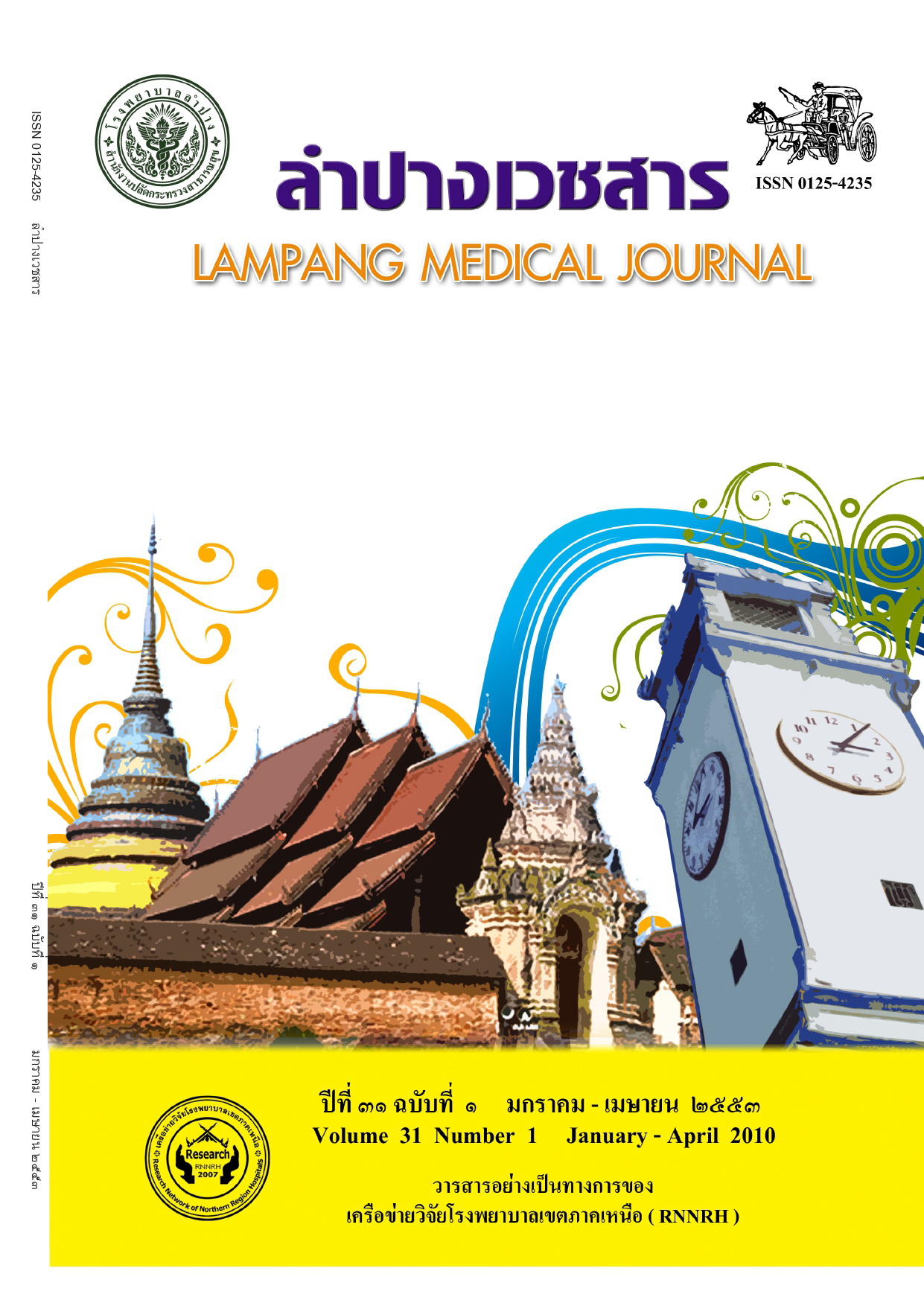Easier Stone Removal During Percutaneous Nephrolithotomy by Using Suction Tube Invented from Teflon Fascial Dilator
Main Article Content
Abstract
Background: Percutaneous nephrolithotomy (PCNL) is the standard treatment of renal calculi. The difficult removal of fragmented stones was commonly found because of the small diameter of conventional suction tube. The author invented a larger suction tube from a Teflon fascial dilator to facilitate this procedure.
Objective: To evaluate outcomes of using the invented suction tube in PCNL comparing with the standard procedure, its complication and users’ satisfaction.
Material and method: A prospectively non-randomized controlled trial was conducted on 60 patients with renal calculi who underwent PCNL in Lampang Hospital between June – September 2009. Stones were removed by conventional technique in the control group and by the invented suction tube in the study group. Patient allocation was purposefully sampled from the patients who had the same stone size. The operation was performed by 5 surgeons in both group equally. Demographic data, stone size, operative time, kidney trauma, surgeons and scrub nurses’ satisfaction were recorded. Data was analyzed by descriptive statistics, t-test, Wilcoxon rank-sum and Fisher’s exact test
Results: Mean age of the patients was 52.9 ± 9.8 years (range, 35-77). Age and gender were not significantly different. The operative time in the study group was less than the control group (22.9±12.9 vs 37.7±26.3 minutes, p<0.01). The mean stone size was 10.5±8.5 cm2 (range, 2.4-46.8). Stone fragments removed by invented tube was 3 times bigger than those removed by conventional tube (0.6 vs 0.2 cm2), but averaged a half size of those removed by the forceps. Most of surgeons found some contusion or abrasion of renal pelvis without hemorrhage. All users satisfied the procedure.
Conclusion: The suction tube invented from Teflon fascial dilator significantly lessened the operative time for stone removal during PCNL. The minimal trauma to renal pelvis was acceptable. All users preferred its ease of use.
Article Details

This work is licensed under a Creative Commons Attribution-NonCommercial-NoDerivatives 4.0 International License.
บทความที่ส่งมาลงพิมพ์ต้องไม่เคยพิมพ์หรือกำลังได้รับการพิจารณาตีพิมพ์ในวารสารอื่น เนื้อหาในบทความต้องเป็นผลงานของผู้นิพนธ์เอง ไม่ได้ลอกเลียนหรือตัดทอนจากบทความอื่น โดยไม่ได้รับอนุญาตหรือไม่ได้อ้างอิงอย่างเหมาะสม การแก้ไขหรือให้ข้อมูลเพิ่มเติมแก่กองบรรณาธิการ จะต้องเสร็จสิ้นเป็นที่เรียบร้อยก่อนจะได้รับพิจารณาตีพิมพ์ และบทความที่ตีพิมพ์แล้วเป็นสมบัติ ของลำปางเวชสาร
References
บรรณกิจ โลจนาภิวัฒน์. ตำรานิ่วในระบบทางเดินปัสสาวะ การเกิดโรค การวินิจฉัย และการรักษา. กรุงเทพมหานคร: บียอนด์ เอ็นเทอร์ไพรซ์; 2548.
บรรณกิจ โลจนาภิวัฒน์. การผ่าตัดในระบบทางเดินปัสสาวะโดยวิธีการส่องกล้อง (Endourology). ใน:วชิร คชการ, บรรณาธิการ. ตำราศัลยศาสตร์ระบบทางเดินปัสสาวะและอวัยวะสืบพันธุ์ชาย. กรุงเทพมหานคร:บียอนด์ เอ็นเทอร์ไพรซ์; 2547. หน้า 269-78.
The Encyclopedia of Surgery. Nephrolithotomy, percutaneous. [cited 19 Sep 2009].
Available from:URL:http://www.surgeryencyclopedia.com/La-Pa/Nephrolithotomy-Percutaneous.html
The Hong Kong Society of Interventional Radiology Ltd. Percutaneous nephrolithotomy and nephrolithotripsy (PCNL) information for patient. [cited 19 Sep 2009]. Available from: URL:http://www.hksir.org.hk/
Vorrakitpokatorn P, Permtongchuchai K, Raksamani E, Phettongkam A. Perioperative complications and risk factors of percutaneous nephrolithotomy. J Med Assoc Thai 2006; 89: 826-33.


